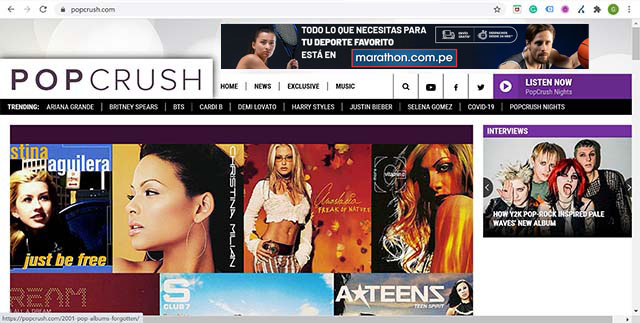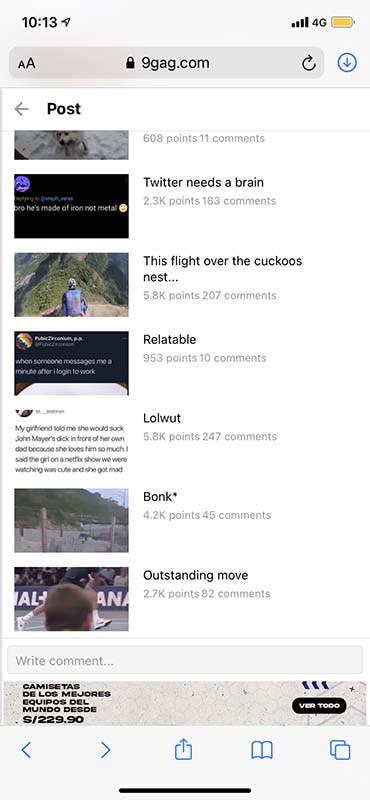Sticky Ads
Everything You Need To Know About Sticky Ads.
Issue that they solve
In the times of bot traffic, ad fraud, and ad block, precious few ads make their way to real people who promptly scroll through the page – looking for something that catches their interest. The rise in digital advertising has provided publishers with a plethora of ad formats that can help in combating these issues.
Advertisers want conversions, and their ads are useless if there’s no one around to see them. For this reason, most advertisers would gladly pay a premium for impressions with a high viewability rate.
There’s also the case of banner blindness which is a matter of concern for both publishers and advertisers. Here’s an expert roundup for publishers we did on reducing banner blindness.
Optimizing for viewability—without jeopardizing user experience can be tricky, but sticky ads walk that fine line with ease.
Types of Sticky Ads
Normally, there are two types of sticky ads: Horizontal and Vertical. Here’s what they look like and where their location generally is:
Horizontal: These ads are present at the top or the bottom of the webpage. They generally spread from one end to the other end of the screen in a landscape manner.
Vertical: Contrary to the landscape size of horizontal sticky ads, vertical ones are portrait-sized and exist on the sides of the webpage.
What the Metrics Say About Their Performance
They perform significantly better than standard display ads, for several reasons.
Now that ads are practically white noise to the online population (read: Banner Blindness), getting views and intentional clicks on ads, clicks that drive sales/conversions for advertisers and raise your traffic’s value on their graph – is a monumental task.
In the face of users’ complete indifference, well-implemented sticky ads refuse to be scrolled past and forgotten; and they do all this without being overly intrusive.
Pros and Cons of Sticky Ads
Like other ad formats, sticky ads have both pros and cons attached to them. While they are majorly preferred by both publishers and advertisers, they come with their own set of disadvantages. We’ve covered major ones below:
Pros
- They increase ad viewability, thus resulting in a higher revenue.
- They are less intrusive to website visitors.
- They can be customized in many ways across different webpages.
Cons
- Some ad networks do not allow sticky ads, so your options can be limited.
- Sticky ads can sometimes reduce the performance of other ad formats.
- Sometimes, they can take up a lot of space on the webpage.
- May ruin a website’s look if proper ad placement is not done.
How to Target Sticky Ads on Blaster?
To successfully target sticky ad inventory you should select ad placement position. You should navigate accordingly:
1. Start to set-up the campaign or edit already created campaign.
2. Navigate to Optimisations, deals & packages section.
3. Expand Ad Placement position.
4. Choose the relevant placement under the dropdown. You can choose more than one placement depending on your business case.
Limitations
Sticky ads won’t be available on all DSP sites and apps. Traffic for these placements will be limited. Therefore, always check traffic discovery.
Traffic for these placements will be limited.
Header (Sticky Ads)
| Creative Size | Impressions |
| 320×50 | 84,912,419 |
| 300×250 | 15,330,892 |
| 728×90 | 14,716,507 |
| 300×50 | 11,764,899 |
| 320×100 | 1,338,140 |
Additionally, almost 70% of all Header sticky ad traffic comes from apps.
| Types | Impressions |
| App | 90,242,763 |
| Site | 39,314,299 |

Full Screen
Full-screen ads that cover the interface of their host app or site. These ads appear between content, so they place at natural transition points or breaks, such as in between activities or game levels. Their full-coverage is what differentiates them from other ad types, like pop-up, native, and banner ads.
Why prefer Interstitial ads:
- Larger sizes leave larger impressions on users
- Higher impression rates mean higher click-through rates
Full Screen ads mostly consists of these ad sizes. Indicating that creative size will be large. Therefore, there is more space to share your message.
| Creative Size | Impressions |
| 320×480 | 37,449,043,850 |
| 480×320 | 3,328,270,323 |
| 768×1024 | 524,727,237 |
| 1024×768 | 158,021,896 |
| 720×1280 | 138,618,425 |
While when it comes to banner and video split for full screen ads, video takes the lead. Over 50% of all possible ad impressions are video ads.
| Creative Type | Impressions |
| Video | 22,016,059,674 |
| Banner | 19,610,650,876 |
Additionally, over 90% of all Full Screen ad traffic comes from apps.
| Types | Impressions |
| App | 41,608,923,201 |
| Site | 17,787,349 |
Footer (Sticky Ads)
A sticky ad is an ad unit which stays visible on the page while the user scrolls through the content of your page. Sticky ads are a non-intrusive format that can be very effective to increase CTR and your Active View metrics.
Footer sticky ads are present at the bottom of the webpage. They generally spread from one end to the other end of the screen in a landscape manner.

Footer sticky ads mostly consists of these ad sizes. Indicating that creative size will be rather small. Therefore, it is essential to fit the information to the banner so it would be well visible.
| Creative Size | Impressions |
| 320×50 | 595,236,964 |
| 300×250 | 175,641,606 |
| 300×50 | 113,459,929 |
| 320×100 | 107,423,631 |
| 728×90 | 67,648,701 |
| 300×100 | 53,788,083 |
| 250×250 | 24,159,372 |
| 336×280 | 16,187,811 |
| 120×600 | 14,937,884 |
| 320×480 | 10,795,127 |
| 970×90 | 9,455,822 |
| 300×600 | 9,376,698 |
| 468×60 | 5,289,943 |
| 728×40 | 3,436,014 |
| 200×200 | 2,565,934 |
| 160×600 | 2,551,965 |
Additionally, almost 84% of all Footer sticky ad traffic comes from sites.
| Types | Impressions |
| Site | 1,032,856,166 |
| App | 190,469,961 |
While, when it comes to countries these are the leading markets with the most traffic for Footer sticky ad.
| Country | Impressions |
| South Africa | 311,413,043 |
| Indonesia | 149,453,649 |
| Serbia | 144,079,956 |
| Nigeria | 102,937,638 |
| Latvia | 78,213,702 |
| Bangladesh | 41,432,005 |
| Kenya | 35,548,890 |
| Japan | 19,843,346 |
| Thailand | 18,588,615 |
| Ghana | 18,200,852 |
| Brazil | 17,927,013 |
| South Korea | 16,374,853 |
| Cambodia | 14,039,755 |
| Israel | 12,866,074 |
| India | 11,770,827 |
| Turkey | 11,482,200 |
| Spain | 11,340,955 |
| Malaysia | 11,239,907 |
| Australia | 10,963,189 |
| Angola | 9,288,849 |
| Global | 1,223,326,127 |
With default optimisation Footer ads may deliver these kind of results:
| Country | Viewability | CTR |
| Nigeria | 77.00% | 0.16% |
| Kazakhstan | 80.46% | 0.39% |
| Kenya | 83.06% | 0.13% |
| Indonesia | 78.84% | 0.23% |
| Bangladesh | 87.32% | 0.12% |
| Total: | 81.54% | 0.21% |
Where the split between apps and sites was rather similar.
| Apps | Sites |
| 52.78% | 47.22% |
Sidebar (Sticky Ads)
A sticky ad is an ad unit which stays visible on the page while the user scrolls through the content of your page. Sticky ads are a non-intrusive format that can be very effective to increase CTR and your Active View metrics.
Sidebar sticky ads contrary to the landscape size of horizontal sticky ads, vertical ones are portrait-sized and exist on the sides of the webpage.
Sidebar sticky ads mostly consists of these ad sizes. Indicating that creative size will be rather small. Therefore, it is essential to fit the information to the banner so it would be well visible.
| Creative Size | Impressions |
| 320×50 | 878,588,743 |
| 300×250 | 447,936,818 |
| 300×50 | 125,748,099 |
| 320×100 | 109,986,378 |
| 120×600 | 86,401,726 |
| 300×100 | 82,902,714 |
| 728×90 | 80,623,027 |
| 250×250 | 70,157,859 |
| 160×600 | 66,512,232 |
| 300×600 | 49,660,600 |
| 336×280 | 37,290,889 |
| 234×60 | 30,786,546 |
| 200×200 | 29,395,316 |
| 160×90 | 16,450,358 |
| 240×400 | 15,631,884 |
| 970×250 | 13,287,764 |
Additionally, almost 99% of all Sidebar sticky ad traffic comes from sites.
| Types | Impressions |
| Site | 2,216,119,289 |
| App | 941,154 |
ADS Specialist
We help agencies and brands plan, execute, and optimize high-performing ad campaigns with engaging custom rich media creatives and advanced targeting.
Help
Contact
Dubai – Silicon Oasis
Miami, Bogotá, Lima, Guatemala
E-mail: [email protected]
Website: https://blaster.biz
